Analysis of Brand Management Strategies: M&S Report
VerifiedAdded on 2021/01/03
|18
|5544
|16
Report
AI Summary
This report provides a comprehensive analysis of brand management, focusing on the case of Marks and Spencer (M&S). The introduction emphasizes the importance of brand management in a competitive business environment, highlighting how a strong brand image can increase customer loyalty. Task 1 explores the significance of branding for an organization, including how it promotes recognition, differentiates from competitors, generates new customers, and builds trust. Task 2 discusses managing a brand portfolio. Task 3 examines brand leverage, including the strengths and weaknesses of the M&S brand and collaborative agreements. The report also delves into brand equity, customer-based brand equity models, brand elements, and key decisions in developing a branding strategy. It suggests strategies for brand extension, reinforcement, and revitalization. Finally, Task 4 evaluates techniques for measuring and managing brand value. The report concludes with a summary of the findings and recommendations for M&S.
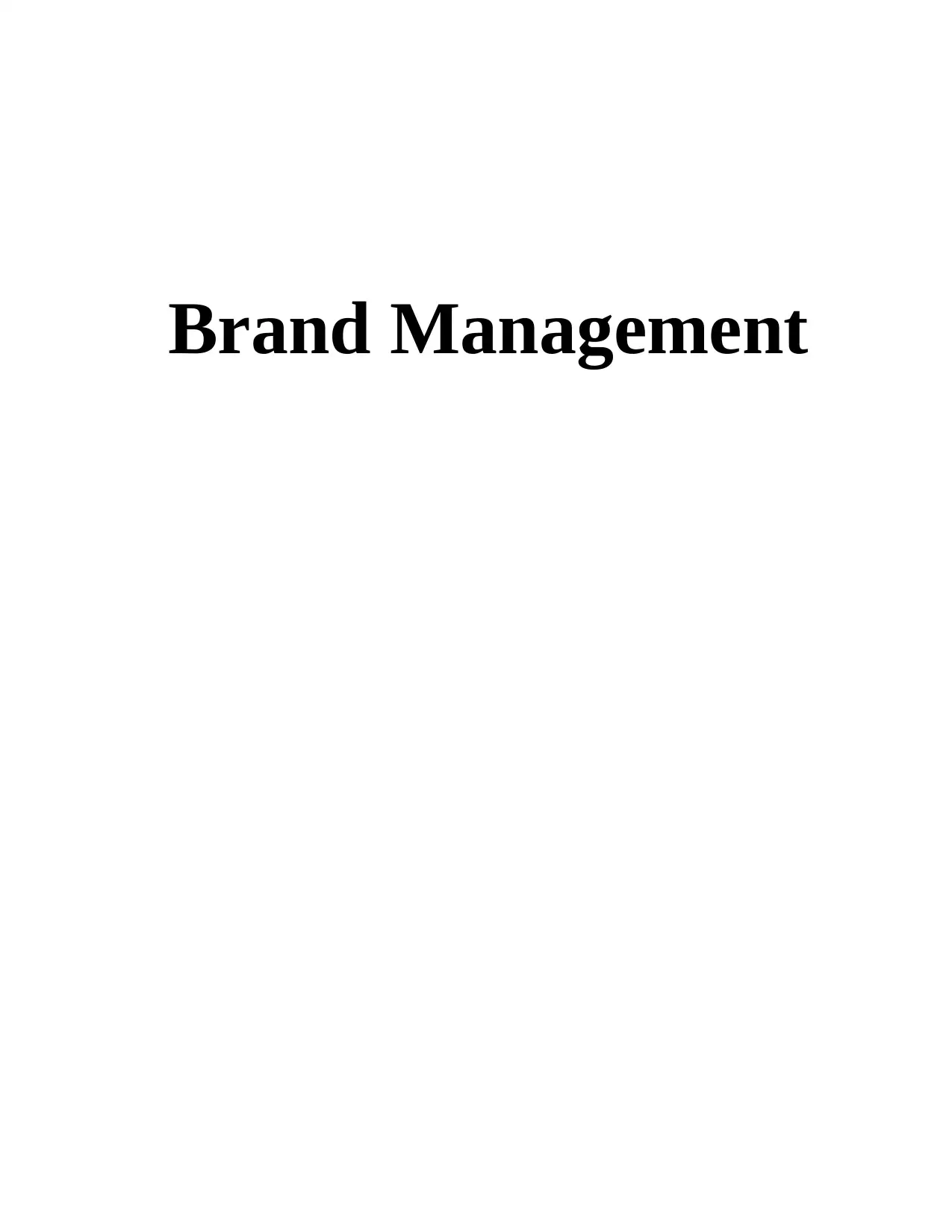
Brand Management
Paraphrase This Document
Need a fresh take? Get an instant paraphrase of this document with our AI Paraphraser
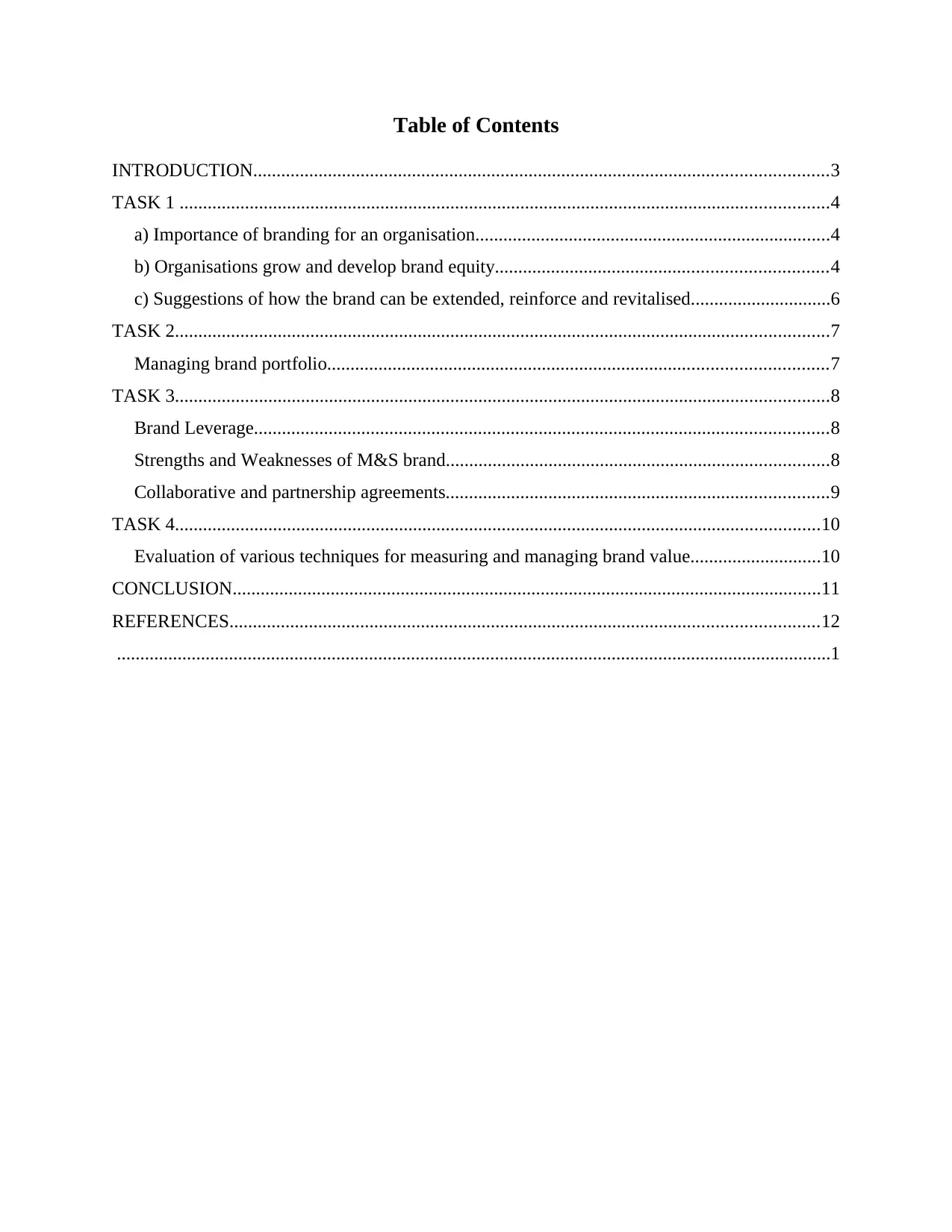
Table of Contents
INTRODUCTION...........................................................................................................................3
TASK 1 ...........................................................................................................................................4
a) Importance of branding for an organisation............................................................................4
b) Organisations grow and develop brand equity.......................................................................4
c) Suggestions of how the brand can be extended, reinforce and revitalised..............................6
TASK 2............................................................................................................................................7
Managing brand portfolio...........................................................................................................7
TASK 3............................................................................................................................................8
Brand Leverage...........................................................................................................................8
Strengths and Weaknesses of M&S brand..................................................................................8
Collaborative and partnership agreements..................................................................................9
TASK 4..........................................................................................................................................10
Evaluation of various techniques for measuring and managing brand value............................10
CONCLUSION..............................................................................................................................11
REFERENCES..............................................................................................................................12
.........................................................................................................................................................1
INTRODUCTION...........................................................................................................................3
TASK 1 ...........................................................................................................................................4
a) Importance of branding for an organisation............................................................................4
b) Organisations grow and develop brand equity.......................................................................4
c) Suggestions of how the brand can be extended, reinforce and revitalised..............................6
TASK 2............................................................................................................................................7
Managing brand portfolio...........................................................................................................7
TASK 3............................................................................................................................................8
Brand Leverage...........................................................................................................................8
Strengths and Weaknesses of M&S brand..................................................................................8
Collaborative and partnership agreements..................................................................................9
TASK 4..........................................................................................................................................10
Evaluation of various techniques for measuring and managing brand value............................10
CONCLUSION..............................................................................................................................11
REFERENCES..............................................................................................................................12
.........................................................................................................................................................1
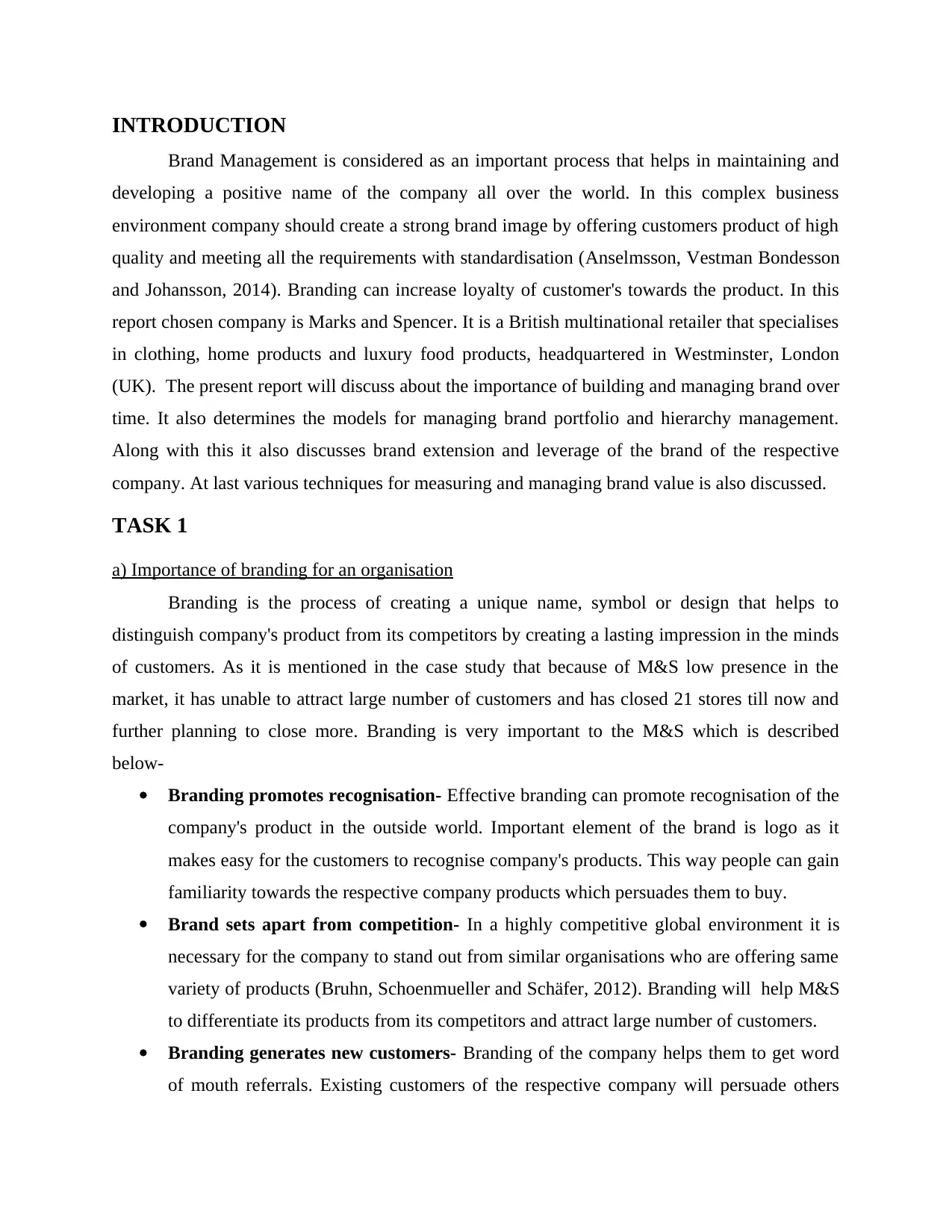
INTRODUCTION
Brand Management is considered as an important process that helps in maintaining and
developing a positive name of the company all over the world. In this complex business
environment company should create a strong brand image by offering customers product of high
quality and meeting all the requirements with standardisation (Anselmsson, Vestman Bondesson
and Johansson, 2014). Branding can increase loyalty of customer's towards the product. In this
report chosen company is Marks and Spencer. It is a British multinational retailer that specialises
in clothing, home products and luxury food products, headquartered in Westminster, London
(UK). The present report will discuss about the importance of building and managing brand over
time. It also determines the models for managing brand portfolio and hierarchy management.
Along with this it also discusses brand extension and leverage of the brand of the respective
company. At last various techniques for measuring and managing brand value is also discussed.
TASK 1
a) Importance of branding for an organisation
Branding is the process of creating a unique name, symbol or design that helps to
distinguish company's product from its competitors by creating a lasting impression in the minds
of customers. As it is mentioned in the case study that because of M&S low presence in the
market, it has unable to attract large number of customers and has closed 21 stores till now and
further planning to close more. Branding is very important to the M&S which is described
below-
Branding promotes recognisation- Effective branding can promote recognisation of the
company's product in the outside world. Important element of the brand is logo as it
makes easy for the customers to recognise company's products. This way people can gain
familiarity towards the respective company products which persuades them to buy.
Brand sets apart from competition- In a highly competitive global environment it is
necessary for the company to stand out from similar organisations who are offering same
variety of products (Bruhn, Schoenmueller and Schäfer, 2012). Branding will help M&S
to differentiate its products from its competitors and attract large number of customers.
Branding generates new customers- Branding of the company helps them to get word
of mouth referrals. Existing customers of the respective company will persuade others
Brand Management is considered as an important process that helps in maintaining and
developing a positive name of the company all over the world. In this complex business
environment company should create a strong brand image by offering customers product of high
quality and meeting all the requirements with standardisation (Anselmsson, Vestman Bondesson
and Johansson, 2014). Branding can increase loyalty of customer's towards the product. In this
report chosen company is Marks and Spencer. It is a British multinational retailer that specialises
in clothing, home products and luxury food products, headquartered in Westminster, London
(UK). The present report will discuss about the importance of building and managing brand over
time. It also determines the models for managing brand portfolio and hierarchy management.
Along with this it also discusses brand extension and leverage of the brand of the respective
company. At last various techniques for measuring and managing brand value is also discussed.
TASK 1
a) Importance of branding for an organisation
Branding is the process of creating a unique name, symbol or design that helps to
distinguish company's product from its competitors by creating a lasting impression in the minds
of customers. As it is mentioned in the case study that because of M&S low presence in the
market, it has unable to attract large number of customers and has closed 21 stores till now and
further planning to close more. Branding is very important to the M&S which is described
below-
Branding promotes recognisation- Effective branding can promote recognisation of the
company's product in the outside world. Important element of the brand is logo as it
makes easy for the customers to recognise company's products. This way people can gain
familiarity towards the respective company products which persuades them to buy.
Brand sets apart from competition- In a highly competitive global environment it is
necessary for the company to stand out from similar organisations who are offering same
variety of products (Bruhn, Schoenmueller and Schäfer, 2012). Branding will help M&S
to differentiate its products from its competitors and attract large number of customers.
Branding generates new customers- Branding of the company helps them to get word
of mouth referrals. Existing customers of the respective company will persuade others
⊘ This is a preview!⊘
Do you want full access?
Subscribe today to unlock all pages.

Trusted by 1+ million students worldwide
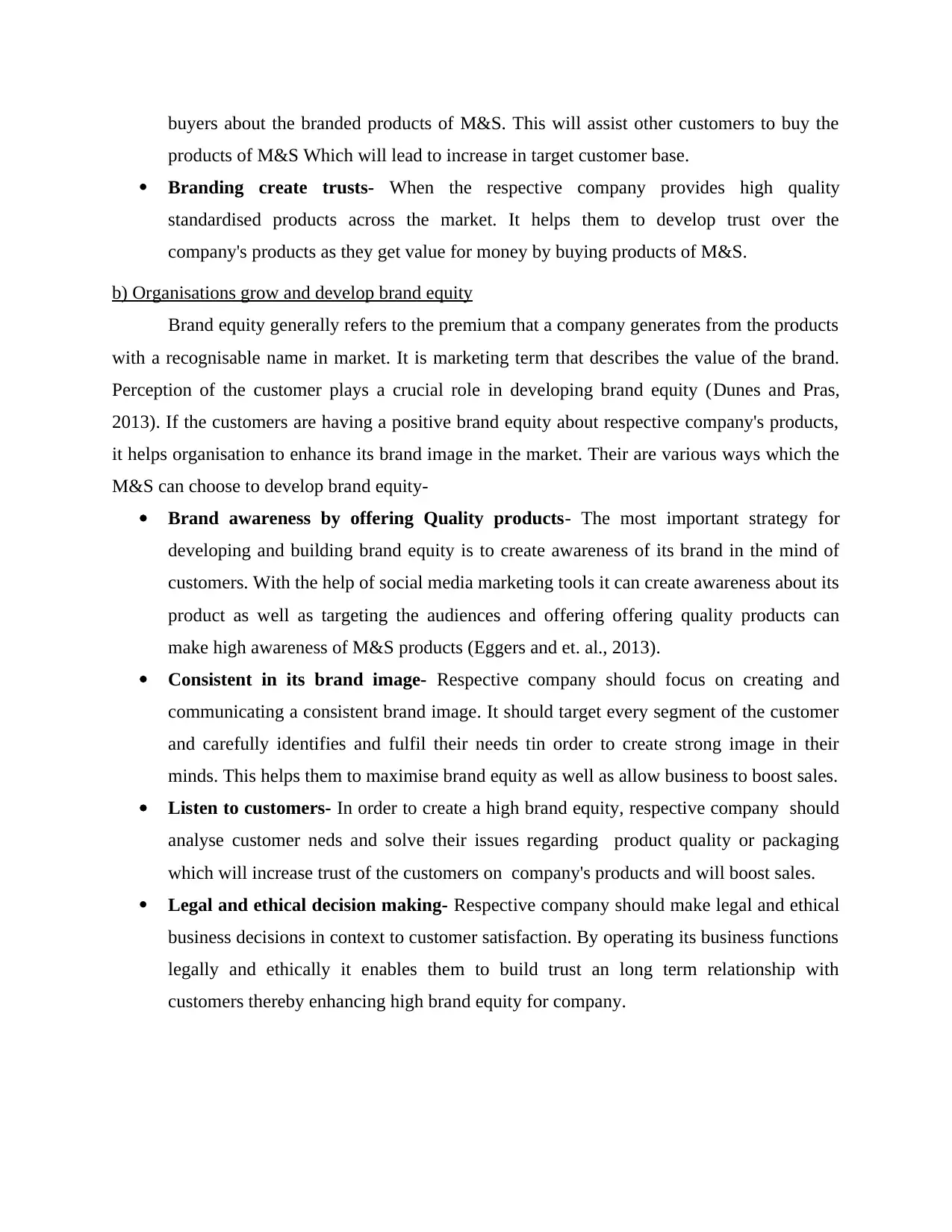
buyers about the branded products of M&S. This will assist other customers to buy the
products of M&S Which will lead to increase in target customer base.
Branding create trusts- When the respective company provides high quality
standardised products across the market. It helps them to develop trust over the
company's products as they get value for money by buying products of M&S.
b) Organisations grow and develop brand equity
Brand equity generally refers to the premium that a company generates from the products
with a recognisable name in market. It is marketing term that describes the value of the brand.
Perception of the customer plays a crucial role in developing brand equity (Dunes and Pras,
2013). If the customers are having a positive brand equity about respective company's products,
it helps organisation to enhance its brand image in the market. Their are various ways which the
M&S can choose to develop brand equity-
Brand awareness by offering Quality products- The most important strategy for
developing and building brand equity is to create awareness of its brand in the mind of
customers. With the help of social media marketing tools it can create awareness about its
product as well as targeting the audiences and offering offering quality products can
make high awareness of M&S products (Eggers and et. al., 2013).
Consistent in its brand image- Respective company should focus on creating and
communicating a consistent brand image. It should target every segment of the customer
and carefully identifies and fulfil their needs tin order to create strong image in their
minds. This helps them to maximise brand equity as well as allow business to boost sales.
Listen to customers- In order to create a high brand equity, respective company should
analyse customer neds and solve their issues regarding product quality or packaging
which will increase trust of the customers on company's products and will boost sales.
Legal and ethical decision making- Respective company should make legal and ethical
business decisions in context to customer satisfaction. By operating its business functions
legally and ethically it enables them to build trust an long term relationship with
customers thereby enhancing high brand equity for company.
products of M&S Which will lead to increase in target customer base.
Branding create trusts- When the respective company provides high quality
standardised products across the market. It helps them to develop trust over the
company's products as they get value for money by buying products of M&S.
b) Organisations grow and develop brand equity
Brand equity generally refers to the premium that a company generates from the products
with a recognisable name in market. It is marketing term that describes the value of the brand.
Perception of the customer plays a crucial role in developing brand equity (Dunes and Pras,
2013). If the customers are having a positive brand equity about respective company's products,
it helps organisation to enhance its brand image in the market. Their are various ways which the
M&S can choose to develop brand equity-
Brand awareness by offering Quality products- The most important strategy for
developing and building brand equity is to create awareness of its brand in the mind of
customers. With the help of social media marketing tools it can create awareness about its
product as well as targeting the audiences and offering offering quality products can
make high awareness of M&S products (Eggers and et. al., 2013).
Consistent in its brand image- Respective company should focus on creating and
communicating a consistent brand image. It should target every segment of the customer
and carefully identifies and fulfil their needs tin order to create strong image in their
minds. This helps them to maximise brand equity as well as allow business to boost sales.
Listen to customers- In order to create a high brand equity, respective company should
analyse customer neds and solve their issues regarding product quality or packaging
which will increase trust of the customers on company's products and will boost sales.
Legal and ethical decision making- Respective company should make legal and ethical
business decisions in context to customer satisfaction. By operating its business functions
legally and ethically it enables them to build trust an long term relationship with
customers thereby enhancing high brand equity for company.
Paraphrase This Document
Need a fresh take? Get an instant paraphrase of this document with our AI Paraphraser
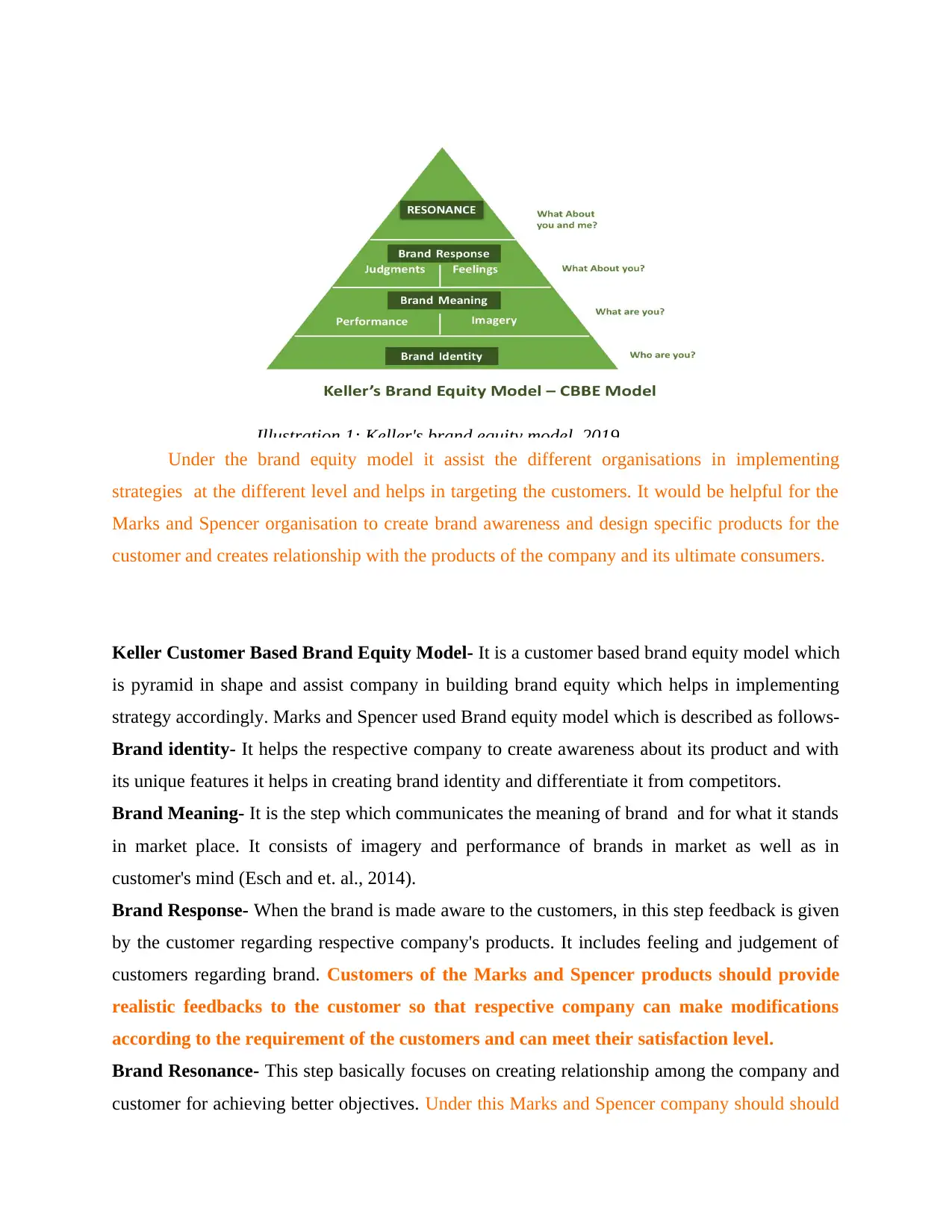
Under the brand equity model it assist the different organisations in implementing
strategies at the different level and helps in targeting the customers. It would be helpful for the
Marks and Spencer organisation to create brand awareness and design specific products for the
customer and creates relationship with the products of the company and its ultimate consumers.
Keller Customer Based Brand Equity Model- It is a customer based brand equity model which
is pyramid in shape and assist company in building brand equity which helps in implementing
strategy accordingly. Marks and Spencer used Brand equity model which is described as follows-
Brand identity- It helps the respective company to create awareness about its product and with
its unique features it helps in creating brand identity and differentiate it from competitors.
Brand Meaning- It is the step which communicates the meaning of brand and for what it stands
in market place. It consists of imagery and performance of brands in market as well as in
customer's mind (Esch and et. al., 2014).
Brand Response- When the brand is made aware to the customers, in this step feedback is given
by the customer regarding respective company's products. It includes feeling and judgement of
customers regarding brand. Customers of the Marks and Spencer products should provide
realistic feedbacks to the customer so that respective company can make modifications
according to the requirement of the customers and can meet their satisfaction level.
Brand Resonance- This step basically focuses on creating relationship among the company and
customer for achieving better objectives. Under this Marks and Spencer company should should
Illustration 1: Keller's brand equity model, 2019
strategies at the different level and helps in targeting the customers. It would be helpful for the
Marks and Spencer organisation to create brand awareness and design specific products for the
customer and creates relationship with the products of the company and its ultimate consumers.
Keller Customer Based Brand Equity Model- It is a customer based brand equity model which
is pyramid in shape and assist company in building brand equity which helps in implementing
strategy accordingly. Marks and Spencer used Brand equity model which is described as follows-
Brand identity- It helps the respective company to create awareness about its product and with
its unique features it helps in creating brand identity and differentiate it from competitors.
Brand Meaning- It is the step which communicates the meaning of brand and for what it stands
in market place. It consists of imagery and performance of brands in market as well as in
customer's mind (Esch and et. al., 2014).
Brand Response- When the brand is made aware to the customers, in this step feedback is given
by the customer regarding respective company's products. It includes feeling and judgement of
customers regarding brand. Customers of the Marks and Spencer products should provide
realistic feedbacks to the customer so that respective company can make modifications
according to the requirement of the customers and can meet their satisfaction level.
Brand Resonance- This step basically focuses on creating relationship among the company and
customer for achieving better objectives. Under this Marks and Spencer company should should
Illustration 1: Keller's brand equity model, 2019
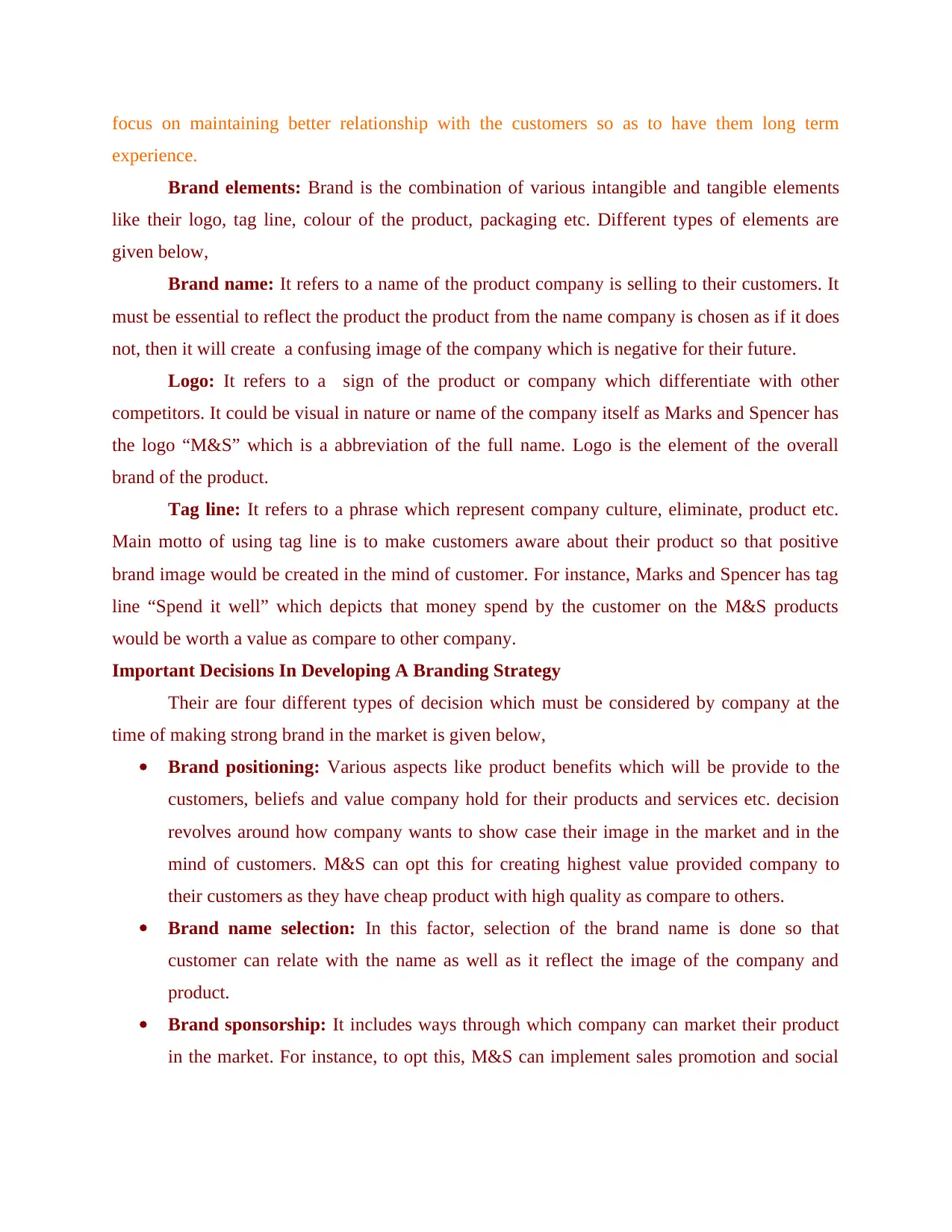
focus on maintaining better relationship with the customers so as to have them long term
experience.
Brand elements: Brand is the combination of various intangible and tangible elements
like their logo, tag line, colour of the product, packaging etc. Different types of elements are
given below,
Brand name: It refers to a name of the product company is selling to their customers. It
must be essential to reflect the product the product from the name company is chosen as if it does
not, then it will create a confusing image of the company which is negative for their future.
Logo: It refers to a sign of the product or company which differentiate with other
competitors. It could be visual in nature or name of the company itself as Marks and Spencer has
the logo “M&S” which is a abbreviation of the full name. Logo is the element of the overall
brand of the product.
Tag line: It refers to a phrase which represent company culture, eliminate, product etc.
Main motto of using tag line is to make customers aware about their product so that positive
brand image would be created in the mind of customer. For instance, Marks and Spencer has tag
line “Spend it well” which depicts that money spend by the customer on the M&S products
would be worth a value as compare to other company.
Important Decisions In Developing A Branding Strategy
Their are four different types of decision which must be considered by company at the
time of making strong brand in the market is given below,
Brand positioning: Various aspects like product benefits which will be provide to the
customers, beliefs and value company hold for their products and services etc. decision
revolves around how company wants to show case their image in the market and in the
mind of customers. M&S can opt this for creating highest value provided company to
their customers as they have cheap product with high quality as compare to others.
Brand name selection: In this factor, selection of the brand name is done so that
customer can relate with the name as well as it reflect the image of the company and
product.
Brand sponsorship: It includes ways through which company can market their product
in the market. For instance, to opt this, M&S can implement sales promotion and social
experience.
Brand elements: Brand is the combination of various intangible and tangible elements
like their logo, tag line, colour of the product, packaging etc. Different types of elements are
given below,
Brand name: It refers to a name of the product company is selling to their customers. It
must be essential to reflect the product the product from the name company is chosen as if it does
not, then it will create a confusing image of the company which is negative for their future.
Logo: It refers to a sign of the product or company which differentiate with other
competitors. It could be visual in nature or name of the company itself as Marks and Spencer has
the logo “M&S” which is a abbreviation of the full name. Logo is the element of the overall
brand of the product.
Tag line: It refers to a phrase which represent company culture, eliminate, product etc.
Main motto of using tag line is to make customers aware about their product so that positive
brand image would be created in the mind of customer. For instance, Marks and Spencer has tag
line “Spend it well” which depicts that money spend by the customer on the M&S products
would be worth a value as compare to other company.
Important Decisions In Developing A Branding Strategy
Their are four different types of decision which must be considered by company at the
time of making strong brand in the market is given below,
Brand positioning: Various aspects like product benefits which will be provide to the
customers, beliefs and value company hold for their products and services etc. decision
revolves around how company wants to show case their image in the market and in the
mind of customers. M&S can opt this for creating highest value provided company to
their customers as they have cheap product with high quality as compare to others.
Brand name selection: In this factor, selection of the brand name is done so that
customer can relate with the name as well as it reflect the image of the company and
product.
Brand sponsorship: It includes ways through which company can market their product
in the market. For instance, to opt this, M&S can implement sales promotion and social
⊘ This is a preview!⊘
Do you want full access?
Subscribe today to unlock all pages.

Trusted by 1+ million students worldwide
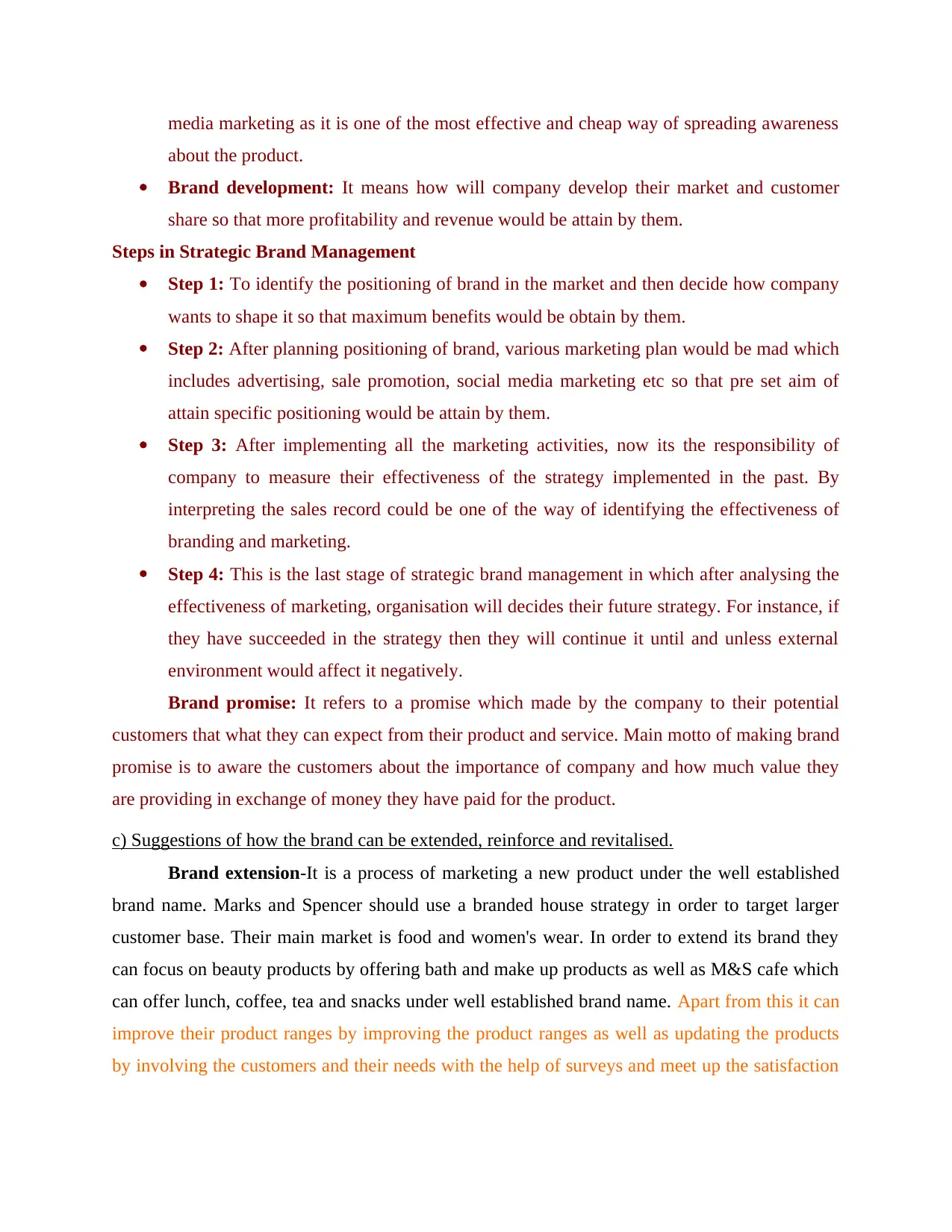
media marketing as it is one of the most effective and cheap way of spreading awareness
about the product.
Brand development: It means how will company develop their market and customer
share so that more profitability and revenue would be attain by them.
Steps in Strategic Brand Management
Step 1: To identify the positioning of brand in the market and then decide how company
wants to shape it so that maximum benefits would be obtain by them.
Step 2: After planning positioning of brand, various marketing plan would be mad which
includes advertising, sale promotion, social media marketing etc so that pre set aim of
attain specific positioning would be attain by them.
Step 3: After implementing all the marketing activities, now its the responsibility of
company to measure their effectiveness of the strategy implemented in the past. By
interpreting the sales record could be one of the way of identifying the effectiveness of
branding and marketing.
Step 4: This is the last stage of strategic brand management in which after analysing the
effectiveness of marketing, organisation will decides their future strategy. For instance, if
they have succeeded in the strategy then they will continue it until and unless external
environment would affect it negatively.
Brand promise: It refers to a promise which made by the company to their potential
customers that what they can expect from their product and service. Main motto of making brand
promise is to aware the customers about the importance of company and how much value they
are providing in exchange of money they have paid for the product.
c) Suggestions of how the brand can be extended, reinforce and revitalised.
Brand extension-It is a process of marketing a new product under the well established
brand name. Marks and Spencer should use a branded house strategy in order to target larger
customer base. Their main market is food and women's wear. In order to extend its brand they
can focus on beauty products by offering bath and make up products as well as M&S cafe which
can offer lunch, coffee, tea and snacks under well established brand name. Apart from this it can
improve their product ranges by improving the product ranges as well as updating the products
by involving the customers and their needs with the help of surveys and meet up the satisfaction
about the product.
Brand development: It means how will company develop their market and customer
share so that more profitability and revenue would be attain by them.
Steps in Strategic Brand Management
Step 1: To identify the positioning of brand in the market and then decide how company
wants to shape it so that maximum benefits would be obtain by them.
Step 2: After planning positioning of brand, various marketing plan would be mad which
includes advertising, sale promotion, social media marketing etc so that pre set aim of
attain specific positioning would be attain by them.
Step 3: After implementing all the marketing activities, now its the responsibility of
company to measure their effectiveness of the strategy implemented in the past. By
interpreting the sales record could be one of the way of identifying the effectiveness of
branding and marketing.
Step 4: This is the last stage of strategic brand management in which after analysing the
effectiveness of marketing, organisation will decides their future strategy. For instance, if
they have succeeded in the strategy then they will continue it until and unless external
environment would affect it negatively.
Brand promise: It refers to a promise which made by the company to their potential
customers that what they can expect from their product and service. Main motto of making brand
promise is to aware the customers about the importance of company and how much value they
are providing in exchange of money they have paid for the product.
c) Suggestions of how the brand can be extended, reinforce and revitalised.
Brand extension-It is a process of marketing a new product under the well established
brand name. Marks and Spencer should use a branded house strategy in order to target larger
customer base. Their main market is food and women's wear. In order to extend its brand they
can focus on beauty products by offering bath and make up products as well as M&S cafe which
can offer lunch, coffee, tea and snacks under well established brand name. Apart from this it can
improve their product ranges by improving the product ranges as well as updating the products
by involving the customers and their needs with the help of surveys and meet up the satisfaction
Paraphrase This Document
Need a fresh take? Get an instant paraphrase of this document with our AI Paraphraser
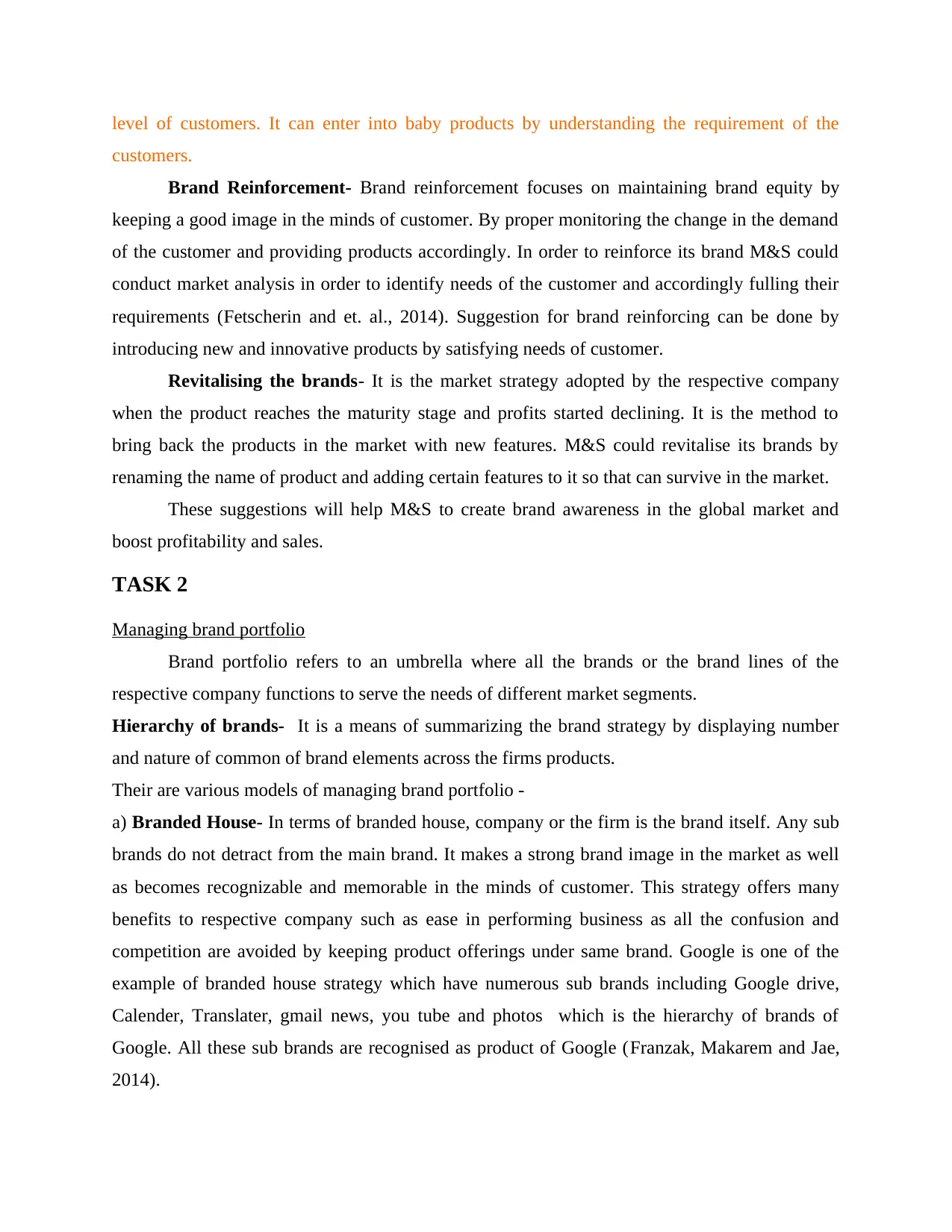
level of customers. It can enter into baby products by understanding the requirement of the
customers.
Brand Reinforcement- Brand reinforcement focuses on maintaining brand equity by
keeping a good image in the minds of customer. By proper monitoring the change in the demand
of the customer and providing products accordingly. In order to reinforce its brand M&S could
conduct market analysis in order to identify needs of the customer and accordingly fulling their
requirements (Fetscherin and et. al., 2014). Suggestion for brand reinforcing can be done by
introducing new and innovative products by satisfying needs of customer.
Revitalising the brands- It is the market strategy adopted by the respective company
when the product reaches the maturity stage and profits started declining. It is the method to
bring back the products in the market with new features. M&S could revitalise its brands by
renaming the name of product and adding certain features to it so that can survive in the market.
These suggestions will help M&S to create brand awareness in the global market and
boost profitability and sales.
TASK 2
Managing brand portfolio
Brand portfolio refers to an umbrella where all the brands or the brand lines of the
respective company functions to serve the needs of different market segments.
Hierarchy of brands- It is a means of summarizing the brand strategy by displaying number
and nature of common of brand elements across the firms products.
Their are various models of managing brand portfolio -
a) Branded House- In terms of branded house, company or the firm is the brand itself. Any sub
brands do not detract from the main brand. It makes a strong brand image in the market as well
as becomes recognizable and memorable in the minds of customer. This strategy offers many
benefits to respective company such as ease in performing business as all the confusion and
competition are avoided by keeping product offerings under same brand. Google is one of the
example of branded house strategy which have numerous sub brands including Google drive,
Calender, Translater, gmail news, you tube and photos which is the hierarchy of brands of
Google. All these sub brands are recognised as product of Google (Franzak, Makarem and Jae,
2014).
customers.
Brand Reinforcement- Brand reinforcement focuses on maintaining brand equity by
keeping a good image in the minds of customer. By proper monitoring the change in the demand
of the customer and providing products accordingly. In order to reinforce its brand M&S could
conduct market analysis in order to identify needs of the customer and accordingly fulling their
requirements (Fetscherin and et. al., 2014). Suggestion for brand reinforcing can be done by
introducing new and innovative products by satisfying needs of customer.
Revitalising the brands- It is the market strategy adopted by the respective company
when the product reaches the maturity stage and profits started declining. It is the method to
bring back the products in the market with new features. M&S could revitalise its brands by
renaming the name of product and adding certain features to it so that can survive in the market.
These suggestions will help M&S to create brand awareness in the global market and
boost profitability and sales.
TASK 2
Managing brand portfolio
Brand portfolio refers to an umbrella where all the brands or the brand lines of the
respective company functions to serve the needs of different market segments.
Hierarchy of brands- It is a means of summarizing the brand strategy by displaying number
and nature of common of brand elements across the firms products.
Their are various models of managing brand portfolio -
a) Branded House- In terms of branded house, company or the firm is the brand itself. Any sub
brands do not detract from the main brand. It makes a strong brand image in the market as well
as becomes recognizable and memorable in the minds of customer. This strategy offers many
benefits to respective company such as ease in performing business as all the confusion and
competition are avoided by keeping product offerings under same brand. Google is one of the
example of branded house strategy which have numerous sub brands including Google drive,
Calender, Translater, gmail news, you tube and photos which is the hierarchy of brands of
Google. All these sub brands are recognised as product of Google (Franzak, Makarem and Jae,
2014).
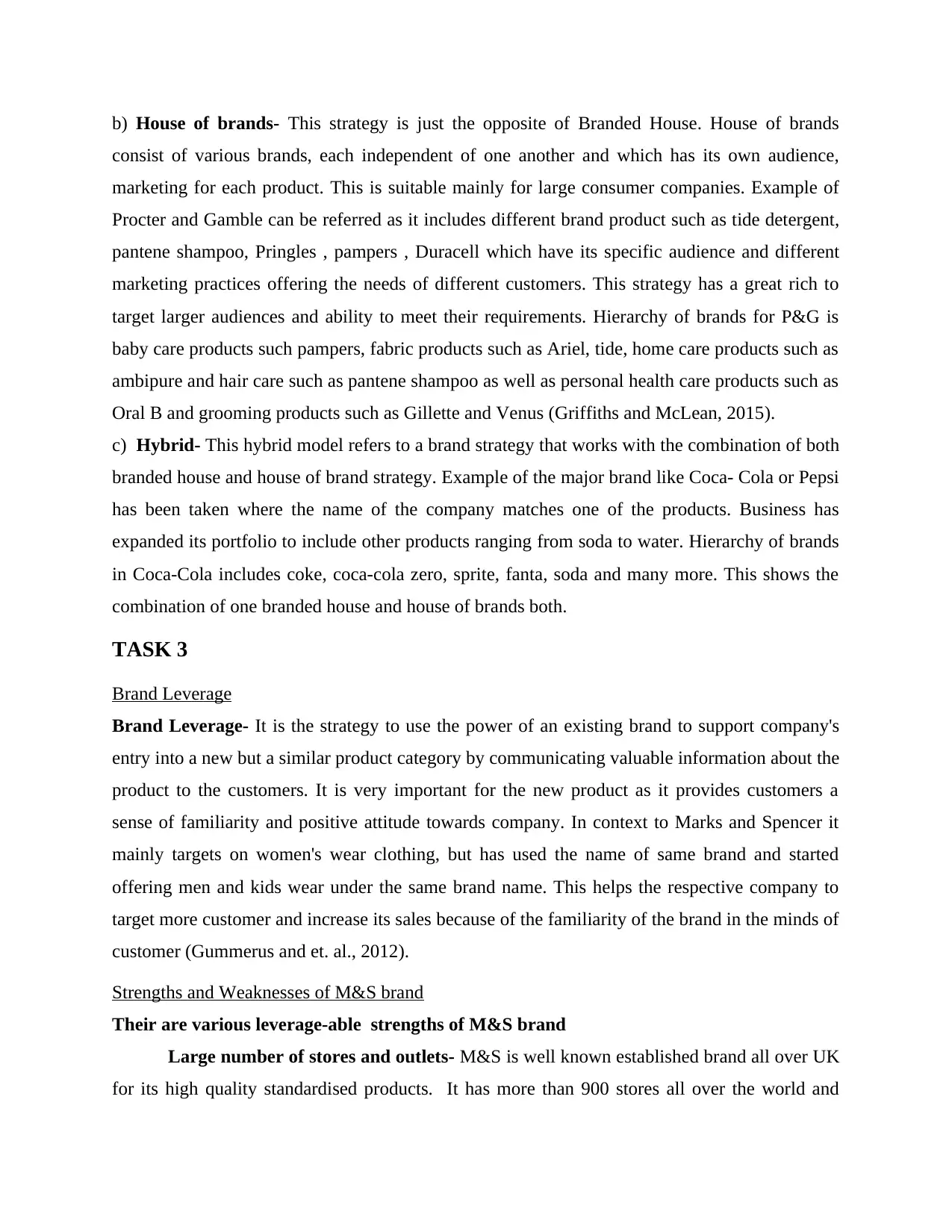
b) House of brands- This strategy is just the opposite of Branded House. House of brands
consist of various brands, each independent of one another and which has its own audience,
marketing for each product. This is suitable mainly for large consumer companies. Example of
Procter and Gamble can be referred as it includes different brand product such as tide detergent,
pantene shampoo, Pringles , pampers , Duracell which have its specific audience and different
marketing practices offering the needs of different customers. This strategy has a great rich to
target larger audiences and ability to meet their requirements. Hierarchy of brands for P&G is
baby care products such pampers, fabric products such as Ariel, tide, home care products such as
ambipure and hair care such as pantene shampoo as well as personal health care products such as
Oral B and grooming products such as Gillette and Venus (Griffiths and McLean, 2015).
c) Hybrid- This hybrid model refers to a brand strategy that works with the combination of both
branded house and house of brand strategy. Example of the major brand like Coca- Cola or Pepsi
has been taken where the name of the company matches one of the products. Business has
expanded its portfolio to include other products ranging from soda to water. Hierarchy of brands
in Coca-Cola includes coke, coca-cola zero, sprite, fanta, soda and many more. This shows the
combination of one branded house and house of brands both.
TASK 3
Brand Leverage
Brand Leverage- It is the strategy to use the power of an existing brand to support company's
entry into a new but a similar product category by communicating valuable information about the
product to the customers. It is very important for the new product as it provides customers a
sense of familiarity and positive attitude towards company. In context to Marks and Spencer it
mainly targets on women's wear clothing, but has used the name of same brand and started
offering men and kids wear under the same brand name. This helps the respective company to
target more customer and increase its sales because of the familiarity of the brand in the minds of
customer (Gummerus and et. al., 2012).
Strengths and Weaknesses of M&S brand
Their are various leverage-able strengths of M&S brand
Large number of stores and outlets- M&S is well known established brand all over UK
for its high quality standardised products. It has more than 900 stores all over the world and
consist of various brands, each independent of one another and which has its own audience,
marketing for each product. This is suitable mainly for large consumer companies. Example of
Procter and Gamble can be referred as it includes different brand product such as tide detergent,
pantene shampoo, Pringles , pampers , Duracell which have its specific audience and different
marketing practices offering the needs of different customers. This strategy has a great rich to
target larger audiences and ability to meet their requirements. Hierarchy of brands for P&G is
baby care products such pampers, fabric products such as Ariel, tide, home care products such as
ambipure and hair care such as pantene shampoo as well as personal health care products such as
Oral B and grooming products such as Gillette and Venus (Griffiths and McLean, 2015).
c) Hybrid- This hybrid model refers to a brand strategy that works with the combination of both
branded house and house of brand strategy. Example of the major brand like Coca- Cola or Pepsi
has been taken where the name of the company matches one of the products. Business has
expanded its portfolio to include other products ranging from soda to water. Hierarchy of brands
in Coca-Cola includes coke, coca-cola zero, sprite, fanta, soda and many more. This shows the
combination of one branded house and house of brands both.
TASK 3
Brand Leverage
Brand Leverage- It is the strategy to use the power of an existing brand to support company's
entry into a new but a similar product category by communicating valuable information about the
product to the customers. It is very important for the new product as it provides customers a
sense of familiarity and positive attitude towards company. In context to Marks and Spencer it
mainly targets on women's wear clothing, but has used the name of same brand and started
offering men and kids wear under the same brand name. This helps the respective company to
target more customer and increase its sales because of the familiarity of the brand in the minds of
customer (Gummerus and et. al., 2012).
Strengths and Weaknesses of M&S brand
Their are various leverage-able strengths of M&S brand
Large number of stores and outlets- M&S is well known established brand all over UK
for its high quality standardised products. It has more than 900 stores all over the world and
⊘ This is a preview!⊘
Do you want full access?
Subscribe today to unlock all pages.

Trusted by 1+ million students worldwide
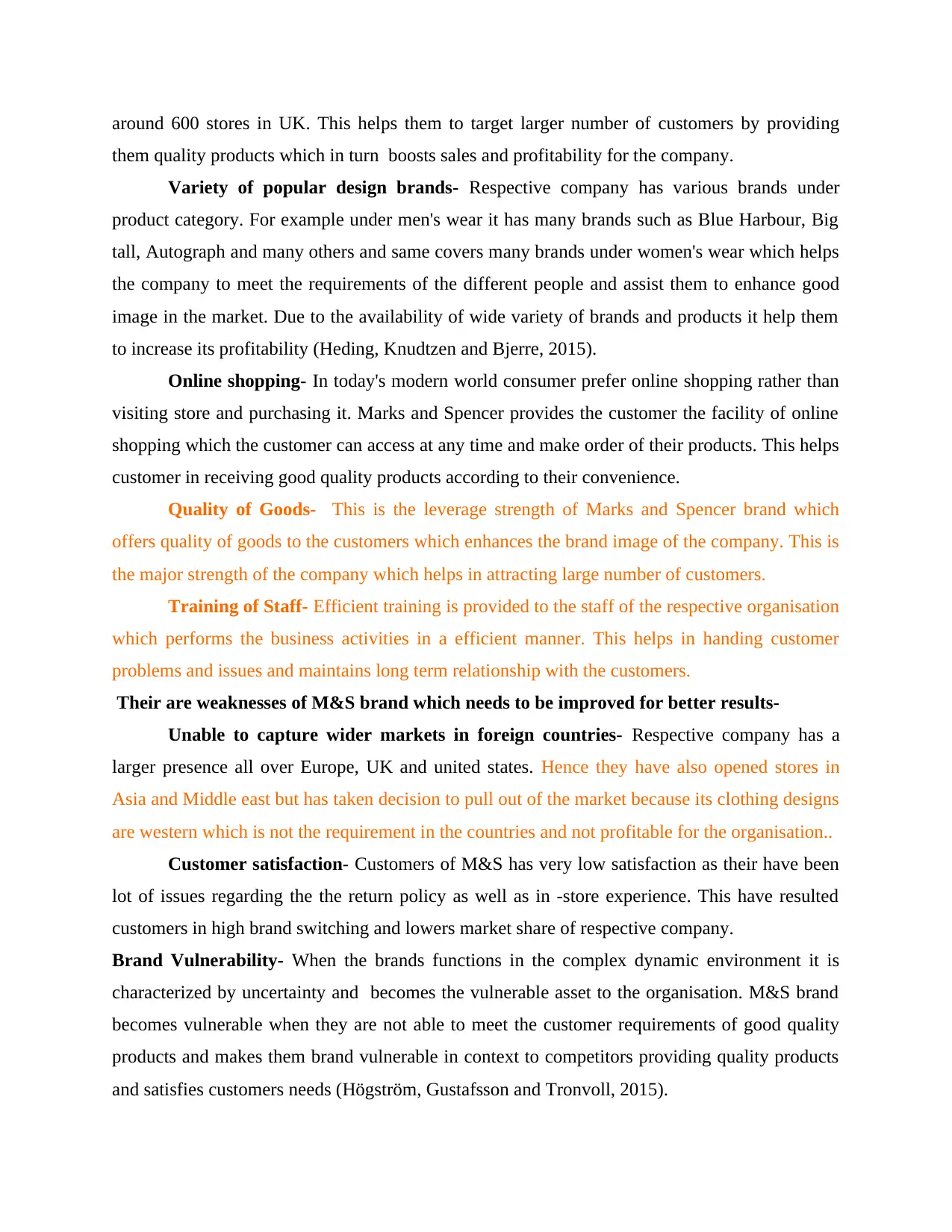
around 600 stores in UK. This helps them to target larger number of customers by providing
them quality products which in turn boosts sales and profitability for the company.
Variety of popular design brands- Respective company has various brands under
product category. For example under men's wear it has many brands such as Blue Harbour, Big
tall, Autograph and many others and same covers many brands under women's wear which helps
the company to meet the requirements of the different people and assist them to enhance good
image in the market. Due to the availability of wide variety of brands and products it help them
to increase its profitability (Heding, Knudtzen and Bjerre, 2015).
Online shopping- In today's modern world consumer prefer online shopping rather than
visiting store and purchasing it. Marks and Spencer provides the customer the facility of online
shopping which the customer can access at any time and make order of their products. This helps
customer in receiving good quality products according to their convenience.
Quality of Goods- This is the leverage strength of Marks and Spencer brand which
offers quality of goods to the customers which enhances the brand image of the company. This is
the major strength of the company which helps in attracting large number of customers.
Training of Staff- Efficient training is provided to the staff of the respective organisation
which performs the business activities in a efficient manner. This helps in handing customer
problems and issues and maintains long term relationship with the customers.
Their are weaknesses of M&S brand which needs to be improved for better results-
Unable to capture wider markets in foreign countries- Respective company has a
larger presence all over Europe, UK and united states. Hence they have also opened stores in
Asia and Middle east but has taken decision to pull out of the market because its clothing designs
are western which is not the requirement in the countries and not profitable for the organisation..
Customer satisfaction- Customers of M&S has very low satisfaction as their have been
lot of issues regarding the the return policy as well as in -store experience. This have resulted
customers in high brand switching and lowers market share of respective company.
Brand Vulnerability- When the brands functions in the complex dynamic environment it is
characterized by uncertainty and becomes the vulnerable asset to the organisation. M&S brand
becomes vulnerable when they are not able to meet the customer requirements of good quality
products and makes them brand vulnerable in context to competitors providing quality products
and satisfies customers needs (Högström, Gustafsson and Tronvoll, 2015).
them quality products which in turn boosts sales and profitability for the company.
Variety of popular design brands- Respective company has various brands under
product category. For example under men's wear it has many brands such as Blue Harbour, Big
tall, Autograph and many others and same covers many brands under women's wear which helps
the company to meet the requirements of the different people and assist them to enhance good
image in the market. Due to the availability of wide variety of brands and products it help them
to increase its profitability (Heding, Knudtzen and Bjerre, 2015).
Online shopping- In today's modern world consumer prefer online shopping rather than
visiting store and purchasing it. Marks and Spencer provides the customer the facility of online
shopping which the customer can access at any time and make order of their products. This helps
customer in receiving good quality products according to their convenience.
Quality of Goods- This is the leverage strength of Marks and Spencer brand which
offers quality of goods to the customers which enhances the brand image of the company. This is
the major strength of the company which helps in attracting large number of customers.
Training of Staff- Efficient training is provided to the staff of the respective organisation
which performs the business activities in a efficient manner. This helps in handing customer
problems and issues and maintains long term relationship with the customers.
Their are weaknesses of M&S brand which needs to be improved for better results-
Unable to capture wider markets in foreign countries- Respective company has a
larger presence all over Europe, UK and united states. Hence they have also opened stores in
Asia and Middle east but has taken decision to pull out of the market because its clothing designs
are western which is not the requirement in the countries and not profitable for the organisation..
Customer satisfaction- Customers of M&S has very low satisfaction as their have been
lot of issues regarding the the return policy as well as in -store experience. This have resulted
customers in high brand switching and lowers market share of respective company.
Brand Vulnerability- When the brands functions in the complex dynamic environment it is
characterized by uncertainty and becomes the vulnerable asset to the organisation. M&S brand
becomes vulnerable when they are not able to meet the customer requirements of good quality
products and makes them brand vulnerable in context to competitors providing quality products
and satisfies customers needs (Högström, Gustafsson and Tronvoll, 2015).
Paraphrase This Document
Need a fresh take? Get an instant paraphrase of this document with our AI Paraphraser
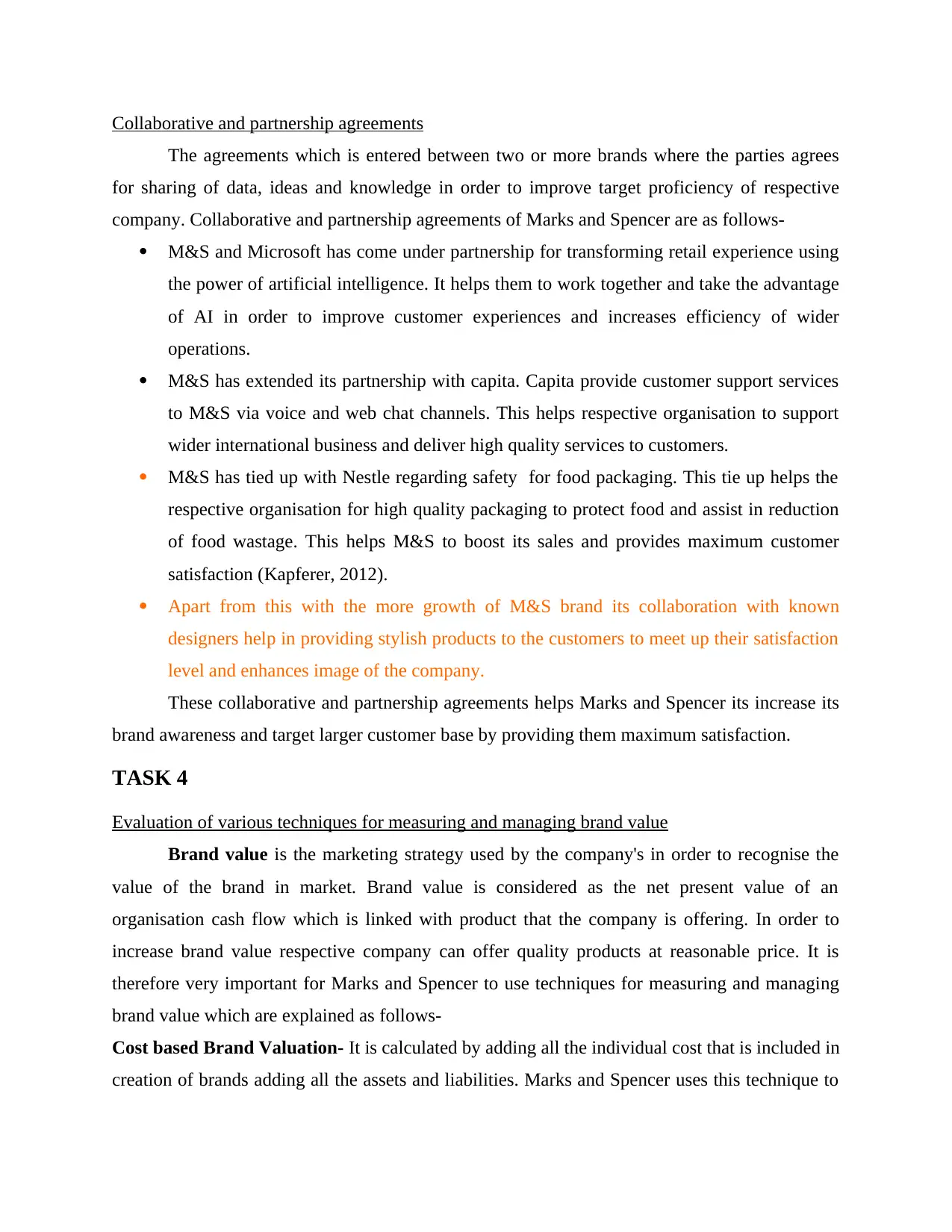
Collaborative and partnership agreements
The agreements which is entered between two or more brands where the parties agrees
for sharing of data, ideas and knowledge in order to improve target proficiency of respective
company. Collaborative and partnership agreements of Marks and Spencer are as follows-
M&S and Microsoft has come under partnership for transforming retail experience using
the power of artificial intelligence. It helps them to work together and take the advantage
of AI in order to improve customer experiences and increases efficiency of wider
operations.
M&S has extended its partnership with capita. Capita provide customer support services
to M&S via voice and web chat channels. This helps respective organisation to support
wider international business and deliver high quality services to customers.
M&S has tied up with Nestle regarding safety for food packaging. This tie up helps the
respective organisation for high quality packaging to protect food and assist in reduction
of food wastage. This helps M&S to boost its sales and provides maximum customer
satisfaction (Kapferer, 2012).
Apart from this with the more growth of M&S brand its collaboration with known
designers help in providing stylish products to the customers to meet up their satisfaction
level and enhances image of the company.
These collaborative and partnership agreements helps Marks and Spencer its increase its
brand awareness and target larger customer base by providing them maximum satisfaction.
TASK 4
Evaluation of various techniques for measuring and managing brand value
Brand value is the marketing strategy used by the company's in order to recognise the
value of the brand in market. Brand value is considered as the net present value of an
organisation cash flow which is linked with product that the company is offering. In order to
increase brand value respective company can offer quality products at reasonable price. It is
therefore very important for Marks and Spencer to use techniques for measuring and managing
brand value which are explained as follows-
Cost based Brand Valuation- It is calculated by adding all the individual cost that is included in
creation of brands adding all the assets and liabilities. Marks and Spencer uses this technique to
The agreements which is entered between two or more brands where the parties agrees
for sharing of data, ideas and knowledge in order to improve target proficiency of respective
company. Collaborative and partnership agreements of Marks and Spencer are as follows-
M&S and Microsoft has come under partnership for transforming retail experience using
the power of artificial intelligence. It helps them to work together and take the advantage
of AI in order to improve customer experiences and increases efficiency of wider
operations.
M&S has extended its partnership with capita. Capita provide customer support services
to M&S via voice and web chat channels. This helps respective organisation to support
wider international business and deliver high quality services to customers.
M&S has tied up with Nestle regarding safety for food packaging. This tie up helps the
respective organisation for high quality packaging to protect food and assist in reduction
of food wastage. This helps M&S to boost its sales and provides maximum customer
satisfaction (Kapferer, 2012).
Apart from this with the more growth of M&S brand its collaboration with known
designers help in providing stylish products to the customers to meet up their satisfaction
level and enhances image of the company.
These collaborative and partnership agreements helps Marks and Spencer its increase its
brand awareness and target larger customer base by providing them maximum satisfaction.
TASK 4
Evaluation of various techniques for measuring and managing brand value
Brand value is the marketing strategy used by the company's in order to recognise the
value of the brand in market. Brand value is considered as the net present value of an
organisation cash flow which is linked with product that the company is offering. In order to
increase brand value respective company can offer quality products at reasonable price. It is
therefore very important for Marks and Spencer to use techniques for measuring and managing
brand value which are explained as follows-
Cost based Brand Valuation- It is calculated by adding all the individual cost that is included in
creation of brands adding all the assets and liabilities. Marks and Spencer uses this technique to
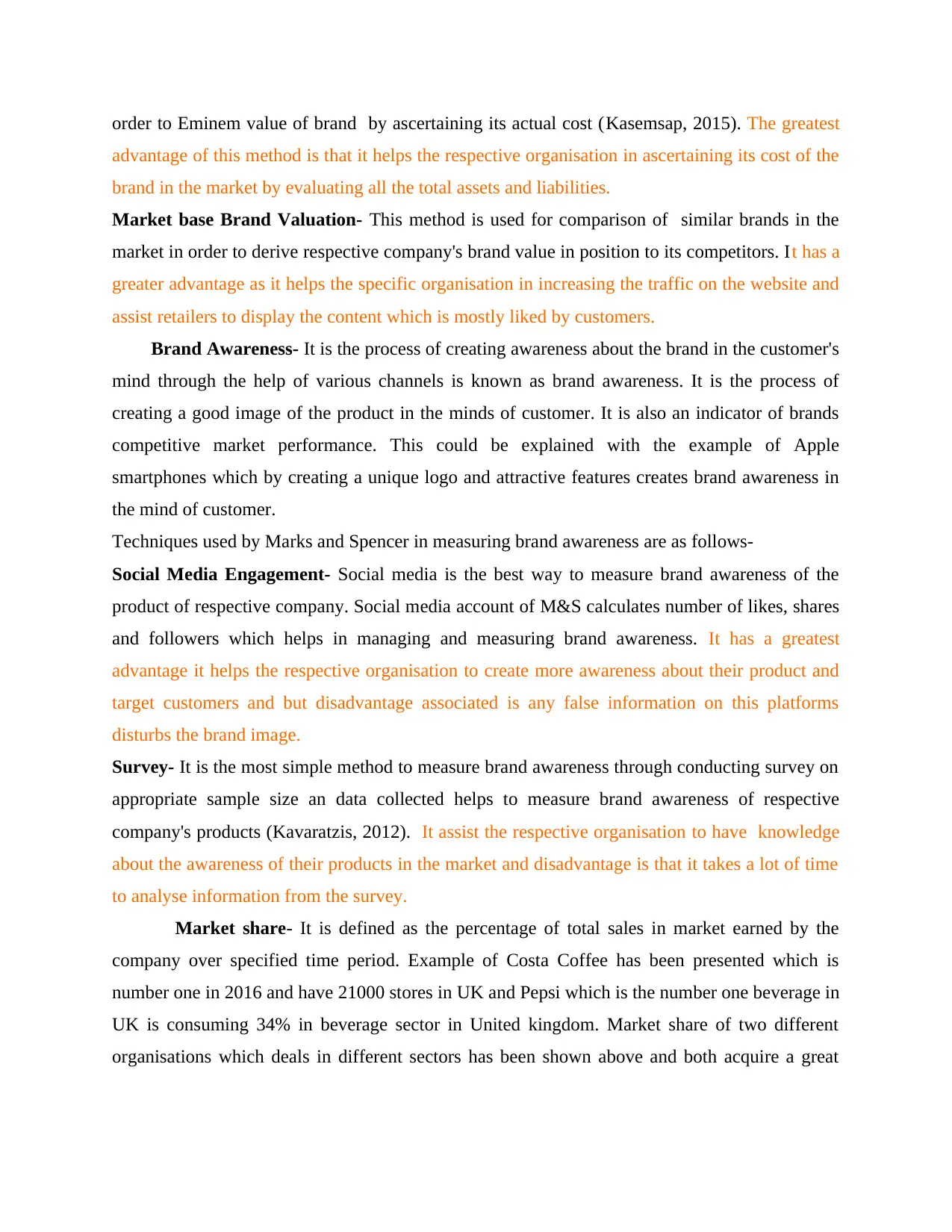
order to Eminem value of brand by ascertaining its actual cost (Kasemsap, 2015). The greatest
advantage of this method is that it helps the respective organisation in ascertaining its cost of the
brand in the market by evaluating all the total assets and liabilities.
Market base Brand Valuation- This method is used for comparison of similar brands in the
market in order to derive respective company's brand value in position to its competitors. It has a
greater advantage as it helps the specific organisation in increasing the traffic on the website and
assist retailers to display the content which is mostly liked by customers.
Brand Awareness- It is the process of creating awareness about the brand in the customer's
mind through the help of various channels is known as brand awareness. It is the process of
creating a good image of the product in the minds of customer. It is also an indicator of brands
competitive market performance. This could be explained with the example of Apple
smartphones which by creating a unique logo and attractive features creates brand awareness in
the mind of customer.
Techniques used by Marks and Spencer in measuring brand awareness are as follows-
Social Media Engagement- Social media is the best way to measure brand awareness of the
product of respective company. Social media account of M&S calculates number of likes, shares
and followers which helps in managing and measuring brand awareness. It has a greatest
advantage it helps the respective organisation to create more awareness about their product and
target customers and but disadvantage associated is any false information on this platforms
disturbs the brand image.
Survey- It is the most simple method to measure brand awareness through conducting survey on
appropriate sample size an data collected helps to measure brand awareness of respective
company's products (Kavaratzis, 2012). It assist the respective organisation to have knowledge
about the awareness of their products in the market and disadvantage is that it takes a lot of time
to analyse information from the survey.
Market share- It is defined as the percentage of total sales in market earned by the
company over specified time period. Example of Costa Coffee has been presented which is
number one in 2016 and have 21000 stores in UK and Pepsi which is the number one beverage in
UK is consuming 34% in beverage sector in United kingdom. Market share of two different
organisations which deals in different sectors has been shown above and both acquire a great
advantage of this method is that it helps the respective organisation in ascertaining its cost of the
brand in the market by evaluating all the total assets and liabilities.
Market base Brand Valuation- This method is used for comparison of similar brands in the
market in order to derive respective company's brand value in position to its competitors. It has a
greater advantage as it helps the specific organisation in increasing the traffic on the website and
assist retailers to display the content which is mostly liked by customers.
Brand Awareness- It is the process of creating awareness about the brand in the customer's
mind through the help of various channels is known as brand awareness. It is the process of
creating a good image of the product in the minds of customer. It is also an indicator of brands
competitive market performance. This could be explained with the example of Apple
smartphones which by creating a unique logo and attractive features creates brand awareness in
the mind of customer.
Techniques used by Marks and Spencer in measuring brand awareness are as follows-
Social Media Engagement- Social media is the best way to measure brand awareness of the
product of respective company. Social media account of M&S calculates number of likes, shares
and followers which helps in managing and measuring brand awareness. It has a greatest
advantage it helps the respective organisation to create more awareness about their product and
target customers and but disadvantage associated is any false information on this platforms
disturbs the brand image.
Survey- It is the most simple method to measure brand awareness through conducting survey on
appropriate sample size an data collected helps to measure brand awareness of respective
company's products (Kavaratzis, 2012). It assist the respective organisation to have knowledge
about the awareness of their products in the market and disadvantage is that it takes a lot of time
to analyse information from the survey.
Market share- It is defined as the percentage of total sales in market earned by the
company over specified time period. Example of Costa Coffee has been presented which is
number one in 2016 and have 21000 stores in UK and Pepsi which is the number one beverage in
UK is consuming 34% in beverage sector in United kingdom. Market share of two different
organisations which deals in different sectors has been shown above and both acquire a great
⊘ This is a preview!⊘
Do you want full access?
Subscribe today to unlock all pages.

Trusted by 1+ million students worldwide
1 out of 18
Related Documents
Your All-in-One AI-Powered Toolkit for Academic Success.
+13062052269
info@desklib.com
Available 24*7 on WhatsApp / Email
![[object Object]](/_next/static/media/star-bottom.7253800d.svg)
Unlock your academic potential
Copyright © 2020–2025 A2Z Services. All Rights Reserved. Developed and managed by ZUCOL.





